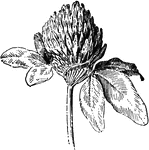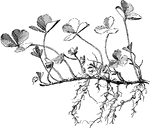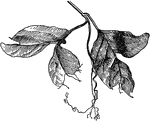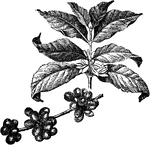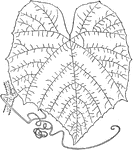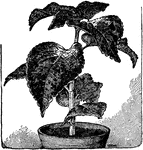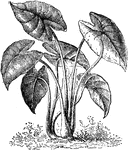775 illustrations of flowers and shrubs including: calla lily, camphor, candlewood, capsicum, carnation, cashew, castor-oil plant, catchfly, catkin, catnip, celandine, chamomile, checkerberry, chickweed, chicory, cinnamon, cinquefoil, cloudberry, clove, clover, cocoa, coffee, colocasia, comfrey, coreopsis, coriander, cornflower, cotton, cowbane, cowslip, crassula, creeper, crocus, and crowfoot.
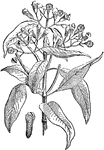
Clove Plant and Seed
Cloves (Syzygium aromaticum, syn. Eugenia aromaticum or Eugenia caryophyllata) are the aromatic dried…
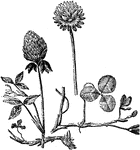
Clover
An illustration of white clover (left) and red clover (right). Clover (Trifolium), or trefoil, is a…

Red Clover Leaf
"A leaf of red clover. At the left, leaf by day; at the right, the same leaf asleep at night." -Bergen,…
Crimson Clover
Crimson clover is the common name of trifolium incarnatum. It is an annual from southern Europe.

Clusia Rosea
"1, full expanded flower; 2, a calyx seen from below; 3, the ovary, with a part of the calyx cut away;…

Cnicus Benedictus
The common name of cnicus is blessed thistle. The benedictus variety grows two feet tall. The flowers…

Cobaea Scandens
Cobaea scandens grows ten to twenty feet tall. The flowers are bell shaped and light violet or greenish…
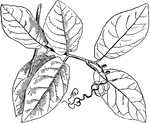
Normal Leaf of Cobaea Scandens
Illustrated is a normal leaf of cobaea scandens. The terminal leaflet is represented by a tendril.

Coca
The flowering branch of the coca plant (Erythroxylon coca) best known for its use in the drug cocaine.
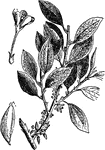
Coca
The coca plant is the source of the coca leaf used in medicine and in the production of cocaine
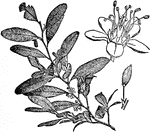
Coca Flower
Coca is a plant in the family Erythroxylaceae, native to north-western South America. The plant plays…

Coca Leaf
The leaf of the coca plant (Erythroxylon coca) best known for its use in the drug cocaine.

Cochlearia Danica
Cochlearia danica grows six to eight inches tall. The leaves are rounded and kidney shaped. The small…
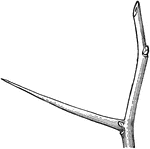
Cockspur Thorn
Spine of Cockspur Thorn developed from an auxiliary bud, as the leaf-scar below witnesses: an accessory…

Coconut Tree
Coconut palm. A, section of fruit; a, husk; b, shell; c, albumin; d, cavity; e, embryo; f, aperture…

Codeso del Pico
"Adenocarpus frankenioides. 1. the standard, wings, and keel split open; 2. the stamens; 3. a cross…
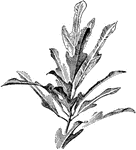
Codiaeum Disraeli
Codieum disraeli is an example of the lobatum form. The leaves are more or less three lobed.
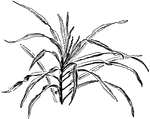
Codiaeum Interruptum
Codiaeum interruptum is an example of the form appendiculatum. The leaves are constricted to the midrib.
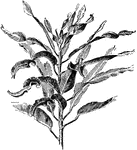
Codiaeum Spirale
Codiaeum spirale is an example of forms crispum and cornutum. The leaves have a crisped margin.
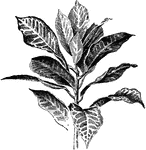
Codiaeum Variegatum Baronne de Rothschild
Codiaeum variegatum Baronne de Rothschild has red colored leaves when older.
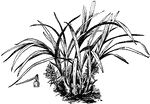
Coelia Baueriana
The flowers of coelia baueriana are small, white, and fragrant. The flower lip is yellow. The plant…
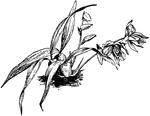
Coelogyne Cristata
The flower clusters of coelogyne cristata have five to nine flowers. The flowers are white and drooping.
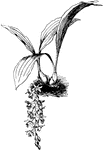
Coelogyne Massangeana
The flowers of coelognye massangeana are two to three inches across. The flowers are pale yellow.
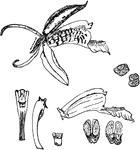
Coelogyne Speciosa
Illustrated are detailed parts of coelogyne speciosa. The flowers are yellow brown.
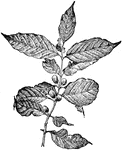
Coffea Arabica
Coffea arabica is a species of coffee indigenous to Ethiopia and Yemen. It is also known as the "coffee…

Coffea Arabica
Coffea Arabica is a species of coffee indigenous to Ethiopia and Yemen. It is also known as the "coffee…

Coffee
Coffee is the berry of a tree found native in Abyssinia. The tree attains a height of 15 to 20 feet,…
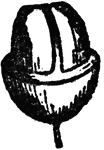
Coffee Bean
"Coffee is the seed of an evergreen shrub, which is cultivated in hot climates, and is a native of Abyssinia…

Coffee Bean
"Coffee is the seed of an evergreen shrub, which is cultivated in hot climates, and is a native of Abyssinia…

Coffee Plant
"Coffee is the seed of an evergreen shrub, which is cultivated in hot climates, and is a native of Abyssinia…
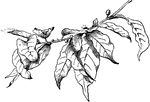
Common or Arabian Coffee
Common or arabian coffee are the common names of coffea arabica. The fruit of the plant is a two seeded,…
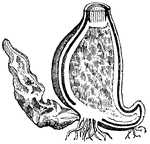
Colchicum
This illustration shows the verticle section of the corm of colchicum, with the withered corm of the…
Colchicum
"A genus of plants of the natural order Melanthaceae. The species, which are few in number, are stemless,…
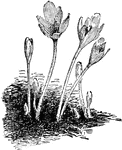
Colchicum Autumnale
The common names of colchicum are meadow saffron and autumn crocus. The autumnale variety has one to…
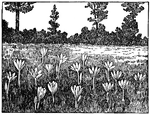
Colchicum Autumnale
Pictured is an autumn blooming bulb. The scientific name of the flower is Colchicum autumnale.

Coleus Blumei Verschaffeltii
The verschaffeltii variety of coleus blumei is more robust and branchy than the type. The leaves are…

Collinsia Bicolor
Collinsia bicolor grows one to two feet tall. The flowers are typically purple and white.

Collinsia Bicolor Alba
The flowers of collinsia bicolor alba are pure white. The flowers can also have a greenish or yellowish…




